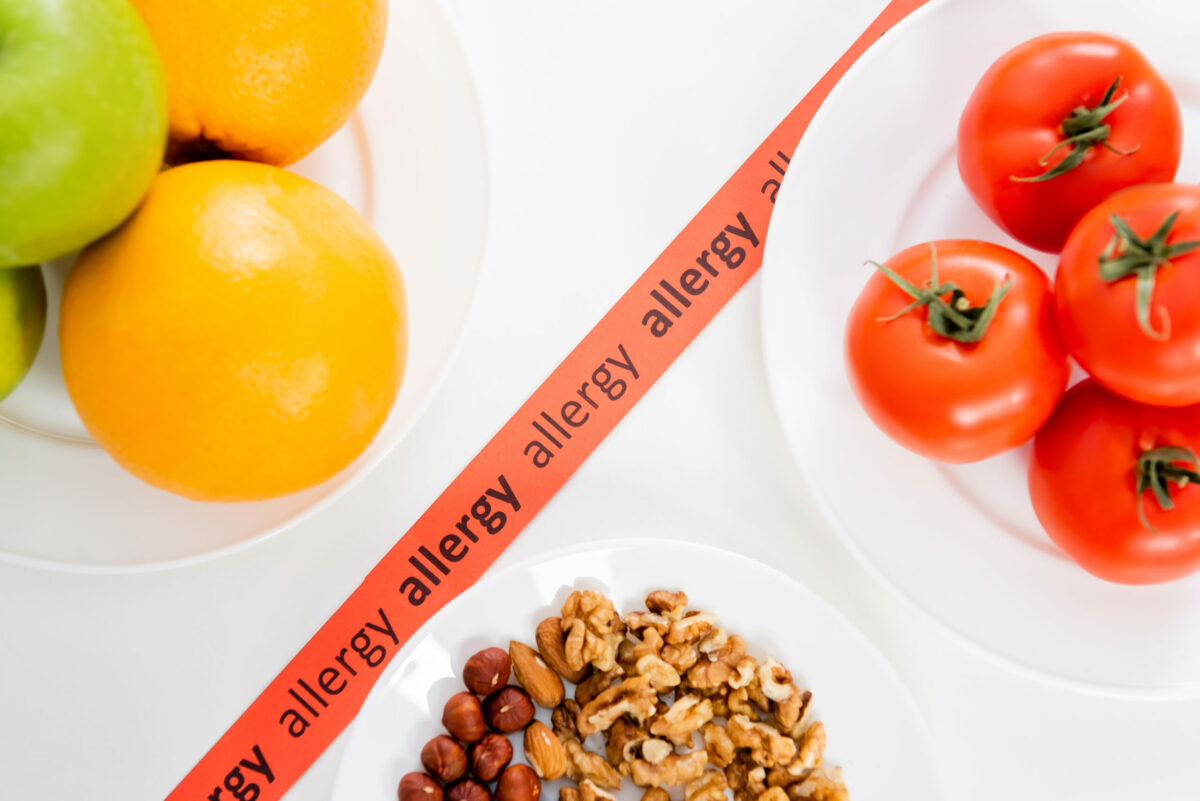An immune system reaction that occurs after eating food is called food allergy. Symptoms such as swollen airways, digestive problems, and hives may appear even due to a small amount of allergy-causing food. Sometimes, this condition may cause severe symptoms or even life-threatening reactions (such as anaphylaxis).
Approximately 8% of children under 5 years old and 4% of adults experience food allergy. While this condition cannot be cured, it disappears sometimes in children when they get older.
Many people mistake food intolerance for food allergy but the first one is less serious because it does not involve the immune system.
Symptoms
While some people experience allergic reactions as something uncomfortable, others may experience severe and even life-threatening symptoms. Commonly, symptoms of this condition appear within two hours after eating the food. In rare cases, the symptoms may appear after more hours. Check below the most common symptoms of food allergy:
- Hives and itching
- Eczema
- Tingling or itching the mouth
- Swelling of the tongue, throat, face, lips, and sometimes other body parts
- Abdominal pain
- Diarrhea
- Nausea
- Vomiting
- Nasal congestion
- Wheezing
- Breathing problems
- Dizziness
- Lightheadedness
- Fainting
Immediately contact your healthcare professional if any of the symptoms listed above happen.
Anaphylaxis
This is a severe allergic reaction that occurs sometimes in people with food allergies. Emergency treatment is essential for this reaction and left untreated can be fatal. Check below some anaphylaxis symptoms:
- Fast heart rate
- Loss of consciousness
- Shock with a sudden drop in blood pressure
- Swollen throat that may cause trouble breathing
- It also causes tightening and constriction of the airways
Going to a doctor right when the symptoms occur may help make a diagnosis easier.
Causes
The immune system mistakenly sees a specific food or a substance from this food as something harmful when a food allergy happens. Therefore, it releases antibodies (called immunoglobulin E or IgE) to fight against allergy-causing food substances (also called allergens). Moreover, IgE antibodies will sense these substances next time even if you eat a small amount of food. As a result, the immune system will begin to release a substance called Histamine and many others into the bloodstream. These substances cause symptoms of allergy. In most cases, food allergies are caused by certain proteins from the following foods. For example:
- Fish
- Chicken eggs
- Cow’s milk
- Wheat
- Soy
- Tree nuts (including pecans and walnuts)
- Peanuts
- Crustacean shellfish (including crab, lobster, and shrimp)
Pollen-food Allergy Syndrome
This condition also is known as oral allergy syndrome and commonly affects people with hay fever. It occurs due to certain fresh fruits and vegetables, nuts, or spices that cause an allergic reaction leading to itching or tingling in the mouth. Some people may experience swelling of the throat or even anaphylaxis.
There are some fruits, vegetables, spices, and nuts that contain the same protein as allergy-causing proteins in some pollens. Usually, symptoms appear when previous products are fresh and uncooked. However, some people experience less severe symptoms when the foods are cooked. Check below for some examples of foods that cause pollen-food allergy syndrome:
- People allergic to birch pollen may also have an allergic reaction to the following foods. For example almonds, apples, apricots, carrots, peanuts, peaches, soybeans, raw potatoes, hazelnuts, and others.
- Allergy to ragweed pollen (foods include banana, cucumber, melon including cantaloupe and watermelon), and zucchini.
- Grasses allergy (the example of foods include oranges, peanuts, tomatoes, white potatoes, and others)
- Allergy to mugwort pollen (for example bell pepper, broccoli, cauliflower, cabbage, onion, celery, peach, and some herbs and spices including black pepper, mustard, fennel, caraway seed, and others).
Exercise-induced Food Allergy
There are some foods that may make you feel lightheaded and itchy right after beginning to exercise. In severe cases, you may experience hives or even anaphylaxis. To prevent this problem, it is not advised to eat for approximately 1-2 hours before exercising.
Food Intolerance
However, a food intolerance may cause similar symptoms to food allergies (including nausea, vomiting, cramping, and diarrhea). The only difference is that if you eat a small amount of food type you have an intolerance symptoms may not occur.
Commonly, it is challenging to diagnose food intolerance because people usually experience this condition due to an ingredient used to prepare food and not to the food itself. Check below some conditions that usually cause symptoms similar to food allergies:
- Reduced levels or lack of an enzyme – For example, some people do not have enough enzymes required to digest lactose, which leads to lactose intolerance and the following symptoms. These include excess gas, diarrhea, cramping, and bloating.
- Food poisoning – In some cases, people experience food poisoning that looks similar to an allergic reaction. It often happens due to bacteria in spoiled tuna or other fish.
- Food additives sensitivity – There are some people who may experience digestive reactions and symptoms due to food additives. These include sulfites used to preserve dried fruits, canned goods, and wine.
- Histamine toxicity – Some products may trigger symptoms similar to food allergies when are not refrigerated properly. It occurs due to increased levels of certain bacteria and Histamine.
- Celiac disease – In some cases, this condition is referred to as gluten allergies. However, it does not involve the immune system and cannot cause anaphylaxis. Celiac disease happens due to foods that contain gluten (a protein found in different foods such as cookies, pasta, bread, and others). An immune reaction occurs in people with this condition when they eat foods that contain gluten, which may lead to damage to the small intestine lining.
Risk Factors
The following factors may increase your risk of developing a food allergy. Examples include:
- Family history – If the following conditions are common in your family, you are more likely to develop a food allergy. For example eczema, asthma, hives, or other allergies such as hay fever.
- Other allergies – If you are allergic to one food the chances you will be at another one are higher. Moreover, the risk of food allergy increases if you have other allergies including eczema and others.
- Age – Commonly, food allergies occur in children, especially infants. When the children grow older a food allergy may go away on its own. However, severe allergies and allergies to nuts and shellfish may be lifelong.
- Asthma – Usually, food allergies and asthma occur at the same time, which makes you more prone to experience severe symptoms.
In addition, check some factors below that increase the risk of an anaphylactic reaction:
- Medical history of asthma
- Delayed use of Epinephrine to treat symptoms of a food allergy
- Not experiencing symptoms (such as hives)
- Being a teenager or younger
Complications
Those who experience food allergies may experience the following complications, especially without treatment. Examples include:
- Anaphylaxis (a life-threatening allergic reaction)
- Atopic dermatitis (also called eczema)
How to Prevent Food Allergy?
As per studies, early introduction of peanut products is associated with a reduced risk of peanut allergy. However, before introducing allergy-causing foods, discuss it with the child’s doctor.
Precautions
Once a food allergy happens, one of the most effective ways to prevent allergic reactions is to avoid foods that cause symptoms. While some people react normally to avoid food, others find it quite difficult. Check below some tips that may help control symptoms:
- Be sure you read the food label carefully before eating or drinking something.
- It is recommended to wear a medical alert bracelet or necklace to inform other people you have an allergic reaction and you cannot communicate.
- Many people with food allergies carry every time an Epinephrine auto-injector. Discuss with your healthcare professional about this medicine.
- It is very important to inform your server or chef about foods you cannot eat when you are in a restaurant.
- You may also take a cooler packed with allergen-free products, especially when you travel or go to an event where you cannot eat a dessert or other foods.
Check below some additional tips that help to ensure your child’s safety if he/she has a food allergy:
- You should talk with childcare providers (including school personnel, parents of the child’s friends, and other adults who interact frequently with your child) about the food allergy.
- It is recommended to teach adults who spend time with your child to recognize the allergic reaction symptoms.
Diagnosis
However, there are no specific tests to confirm or exclude a food allergy. Thus, doctors to diagnose the condition consider the following factors. Examples include:
- Symptoms
- Family history of allergies
- A physical examination results
- Skin test – During this test, doctors will place suspected food on the skin on your back or forearm. Thereafter, they will prick your skin to allow enter small amount of substance under the skin. Allergic people will develop a bump or reaction but even this test is not enough to confirm a food allergy.
- Blood tests – It is done to measure the immune system’s response to different foods.
- Elimination diet – It involves eliminating certain foods from your diet that you suspect may cause symptoms for 1-2 weeks and then returning them back into the diet. While this test cannot tell whether you have a food allergy or not, it may help you identify food sensitivity.
- Oral food challenge – It involves eating small but gradually elevating amounts of food that are suspected to cause symptoms.
Treatment
To prevent allergic reactions usually is enough to avoid eating foods that trigger the symptoms. However, in some cases, it is not possible to prevent contact with that foods. Check below some treatment options often prescribed by doctors for people with a food allergy:
- Minor allergic reactions – These include over-the-counter (OTC) or prescription antihistamines. It is advised to take it after getting in contact with food that causes an allergic reaction.
- Severe allergic reactions – In such cases, people require an emergency Epinephrine injection and they need to go to the emergency room right away. Moreover, most people with food allergies carry an Epinephrine autoinjector (a device that contains a syringe and a concealed needle).
Frequently Asked Questions
Can food allergies be cured?
There is no way to cure this condition but by avoiding the allergy-causing foods, you can prevent the symptoms and complications. One option that may help relieve severe symptoms of food allergies is an Epinephrine autoinjector.
What foods should be avoided by people with food allergies?
- Shellfish
- Peanuts
- Wheat
- Soybeans
- Tree nuts (including almonds, walnuts, and others)
- Fish
- Eggs
- Milk
The list above does not contain all possible foods that you should avoid. For more details, discuss it with your healthcare professional.
What are the primary symptoms of a food allergy?
These include:
- Swelling of the face, lips, or eyes
- Hives
- Breathing problems
- Runny or stuffy nose
- Nausea
- Vomiting
- Diarrhea
- Abdominal pain
- Weakness
If any of the previous symptoms occur, immediately contact your physician. If you have additional questions, ask your doctor.




